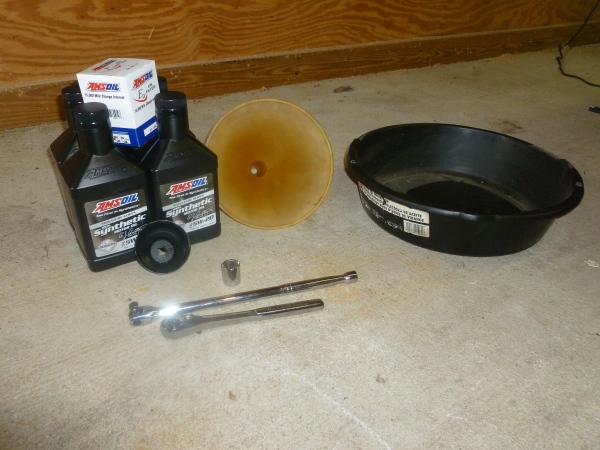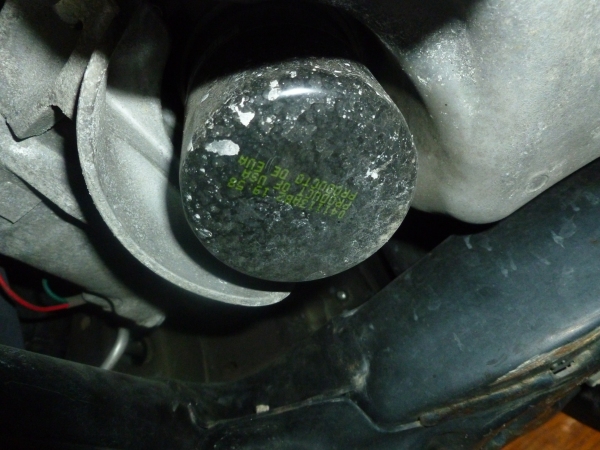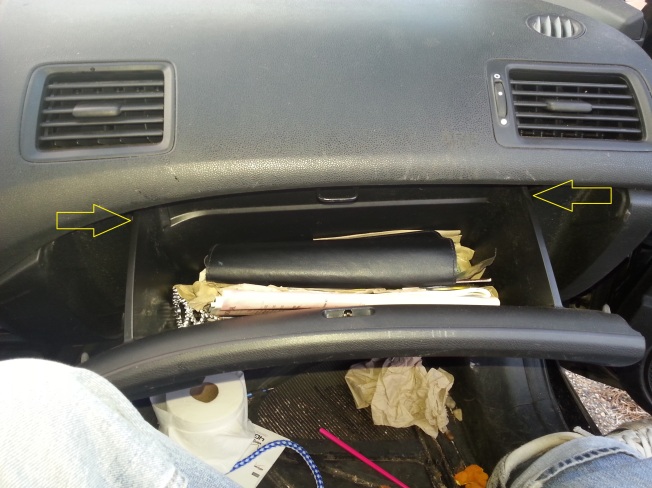
Ok, I know this might be rudimentary for many of you readers out there, however, with the unexpected popularity of my post on changing the third brake light, I figured why not? My reason for writing that post was to reach at least one person to save him or her from unnecessarily spending too much money, so that same reasoning applies here.
If you have never changed your oil before, fear not! This is one of the easiest jobs to do yourself, there is very little risk of screwing things up, and you’ll be able to save yourself a bunch of money! All you need are a few tools, some elbow grease, and about a half hour and you can be a back yard mechanic too. It’s also a great father/son bonding experience (my dad taught me, his dad taught him, I’m sure Sr. taught Jr., and I’ll teach WV when he’s a couple years older).
In this post, I will show you how I change the oil in our 2009 Honda Civic. Different manufacturers (and even different models from the same manufacturer) will have things moved around a bit, but the basic principles still apply. Bottom line up front, here are the steps (explained in further detail below):
Step 1: Elevate the front of the vehicle.
Step 2: Remove drain plug, let oil drain into pan, replace drain plug.
Step 3: Remove filter, let oil drain into pan, replace filter.
Step 4: Refill engine with new oil.
Step 5: Clean up.
Step 6: Check for leaks.
 Here’s a list of what you need:
Here’s a list of what you need:
Ramps or jack stands
Oil pan (that can handle the volume of oil in your engine)
Socket wrench (our Civic takes a 17 mm socket)
Towels/rags
Replacement filter
Replacement oil
Funnel (optional)
Filter wrench (optional)
If you’re not sure what weight/volume of oil or filter type your car needs, consult your owner’s manual. If you cannot find your manual (or the information), then Amsoil has a pretty good app to find out what you need (assuming your vehicle is a 1980 or newer). You don’t have to go with Amsoil for your oil and filter, but the site tells you what your car needs so you can get whatever brand you prefer. Plus, it gives you the option to choose metric or not, so you normal people who use a base 10 measuring system and us silly Americans with our nonsense measuring system can all get the right volumes (1 qt ≈ 0.946 L).
Step 1: Elevate the front of the vehicle. I use ramps. You can get a good pair for around $50, check your local AutoZone/Advance/Pep Boys/etc. Some people prefer to use jack stands, but I think they’re too much of a hassle for changing oil; it’s much easier to set out ramps and drive on up. Heck, you could drive one side of your car onto the curb if you feel like it (and you have a curb). Whatever you do, make sure that the car is secure (parking break on ramps!) before you go crawling underneath it. DO NOT CRAWL UNDERNEATH THE CAR IF IT IS ONLY SUPPORTED BY JACKS. Get yourself some jack stands or ramps, it’s not worth the risk to save a few bucks and be crushed by a car.

Step 2: Make sure the engine is warmed up, but not hot. If you’ve been driving around, put the front end up and let it sit for a while. The oil can get really hot and burn your hands. On the other hand, if it’s really freaking cold outside and the oil has just been chilling (literally) in your engine, then you want to crank the engine and let it run for a bit so the oil flows a little better. Position your oil pan underneath the drain plug, keeping in mind that the laws of physics (gotta love fluid dynamics!) will ensure that the oil will initially shoot farther in the x-direction (using the ground as the x-axis, x = 0 is the point on the x-axis directly below the drain plug) and the stream will gradually move back towards x = 0 as the engine drains. It doesn’t matter which way you define as positive, you don’t want the oil to overshoot the pan. Loosen the drain plug with the socket wrench, and then slowly twist it out with your fingers, keeping pressure against the plug so it doesn’t shoot out and get lost in the oil pan.


Once the oil is done draining, clean up the drain plug, clean around the area where the drain plug goes, and screw it back in there (you can use a torque wrench, but a normal-strengthed person with a normal socket wrench will most likely not over-tighten the plug). Some peoplemanufacturers recommend replacing the drain plug each time you replace the oil. Some cars also have a crush washer that goes between the oil pan and the drain plug that crushes (hence the name) when you tighten the plug and prevents the plug from getting even tighter. Manufacturers also recommend to replace these each time*. The first time I changed the oil in the Civic, I threw away the crush washer. I am still using the same drain plug. See any evidence of leakage in the picture above?
Step 3: Using the filter wrench (or a leather belt, or your hands if you’re Paul Bunyan), loosen the filter, then slowly twist it out using your hand(s). Be sure to keep pressure in the opposite direction, though, otherwise as soon as that filter comes free of the threads, it will slip out of your oily hands and plop right into your oil pan, splashing oil everywhere (yes, I know this from experience). Let the oil drain out of there, wipe out around where the filter screws in, then dip your finger into the used motor oil and spread it around the new filter’s gasket (to ensure a proper seal), and screw the new filter into place. I normally go hand tight (not so I’m straining) plus 1/4 turn with the wrench. Look at all that nastiness from the winter roads on the filter…

Step 4: Double check that you put the drain plug back in (again, speaking from experience). Locate on your engine (under the hood) where the motor oil goes, and unscrew the cap. Using a funnel (or very steady hands), pour the new oil into the opening. My grandfather (and father, and now me) always said “You pay for the oil in the bottom of the bottle,” so I let the bottle sit there and REALLY drain. Screw the cap back on, close the hood, and you’re good to go.


Step 5: Clean up. I transfer the used motor oil into an older container (you could even use the oil bottles you just emptied), stuff the old filter with paper towel, put it back in the box, and put it in a plastic bag with the hole facing upwards so residual oil doesn’t come out. Most shops and municipal waste collection facilities can recycle old oil and filters for you – call around and check. And look at how clean that new oil is compared to the old!
Step 6: Bring the front end of your car back down to the ground, crank it up, check for leaks. I normally let the engine run for about 10 minutes, check underneath for leaks, then check the level with the dipstick. If I did it right, I’ve got the exact level of oil I need. If I didn’t, I either need to drain some or add some (it’s a lot easier to add, so better to undershoot). Take it for a spin (or just leave it running for a few minutes) and come back and re-check for leaks.
I will say, I’m so glad that I finally have my own garage. For the past few years I have had to change the oil (and do all other car maintenance) completely outside. And it always seemed like I chose the windiest day of the year to change the oil. Now I can do my work INSIDE A GARAGE and be somewhat protected from the elements. And eventually I’ll insulate it so I can stay warm in the winter and cool in the summer!
It’s entirely up to you whether you want to use conventional or synthetic oil in your vehicle. I use synthetic, since the Amsoil synthetic is good for 25k miles or 1 year, whichever comes first. A little more expensive up front, but the savings do add up. For full synthetic and the filters (the Amsoil filters for the Civic are only good for 15k miles, so I get two), the total cost comes out to about $60. That’s it. For the entire year. Most shops (at least around here) charge between $20-$30 for a conventional oil change, which has to be done every 3,000 miles. If you drive 15k miles in a year, that’s between $100-$150 you’re spending a year on oil changes. If you’re driving 24k miles a year, you’re up at $160-$240 a year. Even with the up front cost of buying ramps ($50) and tools ($10-$20) you’re spending less in that first year, and the savings add up for each subsequent change. Not to mention saving you the hassle of dropping your car off, waiting, or getting someone else to pick you up and bring you back, and losing the whole day.
So if you’ve never changed your own oil before, go ahead and give it a try. It’s not terribly difficult, and it’s really hard to screw it up. It takes less time and money than taking it to the shop, and it gives you that nice sense of accomplishment of doing something yourself and sticking it to the man!
———————
*I have a hypothesis that stealerships and garages just take an impact wrench to the drain plug and the crush washer prevents them from torquing (not twerking) so hard that the oil pan cracks. This is also why manufacturers recommend replacing the washer and drain plug, because they know people will torque the hell out of them and render them non-reusable. The first time I changed L’s oil in her car when we were dating, I was doing pull-ups on the breaker bar trying to get the dang plug to turn! The manufacturer recommendation is about 30 ft-lbs. At the time, I was about 180 lbs, give or take 5. My breaker bar is 18 inches.


































